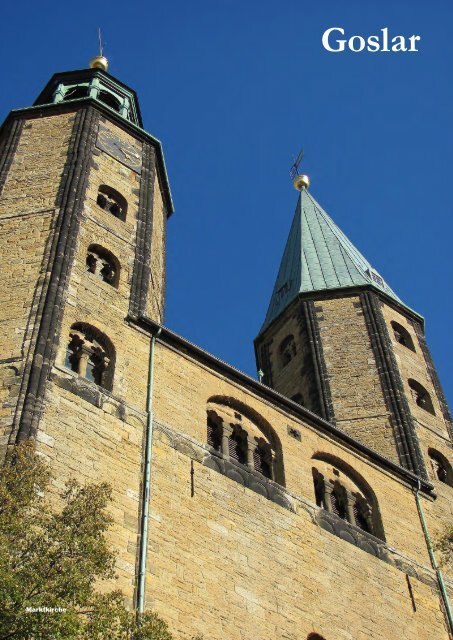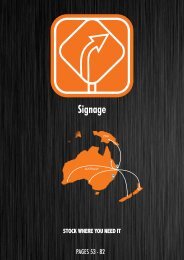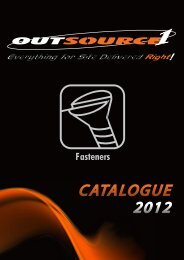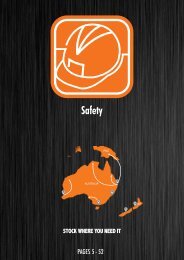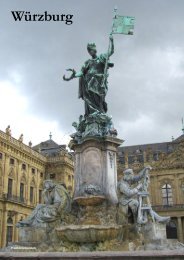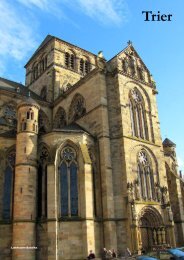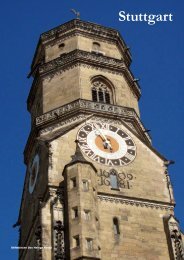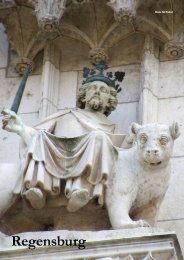Raven Guides: Germany - Goslar
You also want an ePaper? Increase the reach of your titles
YUMPU automatically turns print PDFs into web optimized ePapers that Google loves.
Marktkirche<br />
<strong>Goslar</strong>
<strong>Goslar</strong><br />
The silver mine that provided<br />
the coinage of emperors and the<br />
wealth of powerful families has<br />
left its mark on a millennium-old<br />
town that is now a postcard<br />
for medieval and half-timbered<br />
architecture.<br />
The significance of <strong>Goslar</strong> is in examples<br />
of Romanesque architecture, especially the<br />
Kaiserpfalz and its early churches, and about<br />
1000 town houses built between the 15th and<br />
18th centuries. The priceless streetscapes are<br />
still residential today but little altered by time<br />
and not at all by war. <strong>Goslar</strong>’s old town and<br />
the nearby Rammelsberg mines that funded it<br />
have UNESCO world heritage listing.<br />
The district’s mines produced copper, lead,<br />
zinc, and gold and were an important source<br />
for metallic ores before the time of Christ. But<br />
silver was foremost and <strong>Goslar</strong> was therefore<br />
critical from the earliest days of the German<br />
kingdom in the 10th century. The chronicles<br />
put the founding of <strong>Goslar</strong> at 922 at the<br />
direction of the emperor Heinrich I. It became<br />
an imperial seat for Heinrich II early in the<br />
11th century and the present palace was begun<br />
by Heinrich III a few decades later, becoming<br />
a favourite summer residence of the monarchs<br />
and being visited by a pope. Heinrich III’s<br />
heart was laid to rest in <strong>Goslar</strong>, where his son<br />
Heinrich IV was born. Its main churches were<br />
positioned on an imaginary cross and there<br />
were almost 50 religious foundations.<br />
<strong>Goslar</strong> inevitably became the object of<br />
power struggles. The greatest was between the<br />
Hohenstaufen emperor Frederick Barbarossa<br />
and his mightiest subject Henry the Lion, duke<br />
of Saxony. Henry administered <strong>Goslar</strong> in fief<br />
from the emperor but made a play to secure<br />
lordship, refusing to support Frederick’s<br />
designs on Italy. Frederick hit back – Henry<br />
was stripped of all lands and exiled, but left<br />
a bequest in the shape of wrecked mines and<br />
processing works, which took a generation to<br />
rebuild.<br />
In the 1250s the emperor Friedrich II<br />
granted the mine to the duchy of Brunswick,<br />
which leased it back to the town, but the town’s<br />
imperial connection was renewed by the<br />
declaration of the free imperial city in 1340.<br />
<strong>Goslar</strong> also joined the Hanseatic League and<br />
contributed to the wealth of its great period in<br />
the 13th and 14th centuries.<br />
Trade and crafts were important but mining<br />
wealth was the real foundation for the richly<br />
decorated half-timbered houses, most two<br />
or three-storey, built from the 16th century.<br />
Many have colourful dedications carved into<br />
the beams over their doors in dialect or Latin,<br />
often with dates. Overhangs of the upper<br />
storeys are common and some of the bigger<br />
buildings have galleries or inner courtyards<br />
and carry monograms of the owners. Slate<br />
roofs (and some slate facades) are also<br />
characteristic of the town.<br />
But in another long tussle between the free<br />
city and Brunswick’s ducal house <strong>Goslar</strong> lost<br />
control of cash flows from the mid 16th century.<br />
So the old town has changed little apart<br />
from the 19th century loss of large sections<br />
© 2014 RAVEN TRAVEL GUIDES GERMANY<br />
RAVEN QUICK GUIDE<br />
Tourist information & accommodation service: Markt 7 (tel 05321-78060, email<br />
tourist-information@goslar.de, Apr-Oct M-F 9.15-18, Sa 9.30-16, Su 9.30-14, Nov-Mar<br />
M-F 9.15-17, Sa 9.30-14.<br />
Money: Sparda-Bank, Breite Straße 84 (M-Tu & Th 9-13,14-18, W & F 9-13); Santander<br />
Consumer Bank, Hokenstraße 18 (M-Tu & Th 9-13, 14-19, W & F 9-13, 14-16); Sparkasse,<br />
Jakobikirchhof 5 (M-Tu & Th 9-13, 14-16, W & F 9-13).<br />
Lockers: Rail station hall (€4/2.50 per day).<br />
Post: Klubgartenstraße 10 (M-F 9-18, Sa 9-12.30).<br />
Laundry: City-Textilpflege, Petersilienstraße 9 (M-F 8-18, Sa 9-13).<br />
Police: tel 110; Heinrich-Pieper-Straße 1 (tel 05321-3390).<br />
Pharmacy: Hirsch-Apotheke, Schuhhof 3 (M-F 8-18.15, Sa 9-14); Die Apotheke am<br />
Krankenhaus, Kösliner Straße 10B (M-Sa 8-20); Niedersachsen Apotheke, Rosentor<br />
Straße 24 (M-F 8.30-18, Sa 10-13).<br />
Ambulance: tel 112.<br />
Peterstraße, top, has half-timbered<br />
designs from various periods.<br />
One of the grander restorations,<br />
left, is a 16th century house in<br />
Bäckerstraße, now known as<br />
Ackerbürgerhaus Beck. Breite<br />
Straße, above, and Breites Tor.<br />
Hospital: Asklepios Harzklinik <strong>Goslar</strong>, Kösliner Straße 12 (tel 05321-440).<br />
RAVEN TRAVEL GUIDES GERMANY - <strong>Goslar</strong> 1
of medieval wall and collegiate church of St<br />
Simeon and St Jude. From late in the 19th<br />
century <strong>Goslar</strong> and several nearby mining<br />
towns became spa and winter sports venues.<br />
The last productive Rammelsberg silver<br />
mine closed in 1988 after more than 1000<br />
years of activity. As a symbol of mining<br />
prosperity 10 lumps of ore have been mounted<br />
around the modern city and at Rammelsberg.<br />
The Harz mountains have preserved the once<br />
widespread German tradition of the Walpurgis<br />
festival on the eve of spring. Goethe and Jakob<br />
Grimm associated the summit of Brocken with<br />
witch dances at this time but several sites in<br />
the mountains are popularly associated with<br />
these rituals.<br />
The 11th century Romanesque Kaiserpfalz (Apr-Oct M-Su 10-17, Nov-Mar M-Su 10-16,<br />
€7.50/4.50) on the hill at Kaiserbleek is tied up with the symbols of power, one the biggest<br />
surviving secular medieval structures in <strong>Germany</strong>. The 50m long main Kaiserhaus (c1050)<br />
was restored from ruin in the 1870s with monumental interior paintings in the Kaisersaal<br />
by Hermann Wislicenus, relating stories of German medieval greatness – a restoration in<br />
more ways than one in the way it coopts traditions of the ancient Holy Roman empire to<br />
Prussia’s claim to the German imperial title. The statues of the emperors Frederick<br />
Barbarossa and the Prussian Wilhelm I in front drive home the message. The Pfalzkapelle<br />
St Ulrich, where the heart of Heinrich III is interred, has an octagonal top storey on the<br />
base of a Greek cross, like Charlemagne’s chapel at Aachen. Historical exhibits in the<br />
lower vaults include the original eagle from the Markt fountain and the original imperial<br />
throne used in the coronation of Wilhelm I in Berlin. Henry Moore’s sculpture <strong>Goslar</strong>er<br />
Krieger (1975) is behind the palace. Take bus 803, 804 or 806 to Kaiserpfalz.<br />
One of the valuable few Romanesque buildings in <strong>Goslar</strong>,<br />
with archway, chapel and traditional courtyard,<br />
is Großes Heiliges Kreuz (1254) on Hoher Weg,<br />
formerly a hospice from an alms house foundation. Part<br />
remains in use as aged-care accommodation, but<br />
internal modifications through the 17th century created<br />
rooms now used as workshops and studios (Apr-Dec<br />
Tu-Su 11-17, Jan-Mar Tu-Sa 11-17) for products in<br />
wood, glass, textiles and paper. Take bus 803, 804 or 806<br />
to Kaiserpfalz.<br />
The Romanesque Domvorhalle (1150) below the<br />
Kaiserpfalz contains a copy of the contemporary imperial<br />
throne, last used to crown Wilhelm I in Berlin. It is the<br />
surviving vestibule of the 11th century church<br />
(consecrated by the German pope Victor II to St Simon<br />
and St Jude on his 1056 visit), torn down early in the 19th<br />
century due to the lack of funds for restoration. Its outline<br />
is traced by paving stones in the adjacent car park and<br />
sculpture and columns from the building form part of the<br />
display. The ornate central pillar of the surviving portal<br />
should be noted. Take bus 803, 804 or 806 to Kaiserpfalz.<br />
The Lohmühle (1532), the tanners’ mill,<br />
was one of almost 30 mills once lining the<br />
Abzucht, which cascades down the hill<br />
through the town and was the artery – and<br />
effluent course – for many of the town’s<br />
craftsmen. The Lohmühle’s wheel drove<br />
a grinding mechanism to extract tannin<br />
from oak bark and was later used to mix<br />
cement. Such streams, which were usually<br />
canalised, were indispensable for many<br />
town trades. The building now houses the<br />
Zinnfigurenmuseum. Take bus 803, 804 or<br />
806 to Kaiserpfalz.<br />
Altstadt<br />
A natural starting point for a walk is near<br />
the rail station at the old Achtermann wall<br />
bastion near the roundabout at the north end<br />
of Rosentorstraße – opposite is the remnant<br />
of the old gate Rosentor. To the south Rosentorstraße<br />
becomes a pedestrian precinct,<br />
passing the Romanesque Neuwerkkirche and<br />
half-timbered Mönchehaus and leading past<br />
the Jakobikirche at Jakobikirchhof.<br />
At Bäckerstraße divert east to follow<br />
Fischemäkerstraße south to Markt, centre of<br />
the medieval buildings. Beyond Markt’s east<br />
corner Domstraße then leads south to An der<br />
Abzucht beside the canal. Follow the canal<br />
west to Klapperhagen onto Hoher Weg. A turn<br />
south again past Großes Heiliges Kreuz brings<br />
the Romanesque Domvorhalle into view.<br />
There, from Kaiserbleek, the Kaiserpfalz dominates<br />
the hillside from the west, its terrace<br />
providing a view over the town.<br />
Down the steps north of the palace<br />
Heerwinkel winds back to the Abzucht at<br />
Neue Straße, which at the west end connects<br />
with Bergstraße. Following the street west<br />
leads onto Peterstraße, one of the densest<br />
concentrations of half-timbered houses, and<br />
Ziegenstraße turns toward Frankenberger Plan<br />
just below the Frankenbergkirche.<br />
Frankenberger Straße leads north-east<br />
and a turn south on Schreiberstraße leads to<br />
Bergstraße past some of the finest half-timbered<br />
buildings. At Stoben is the quirky Brusttuch,<br />
opposite the towers of the Marktkirche. At its<br />
south-west corner is Schuhhof, probably the<br />
oldest of the town squares, adjacent to Markt.<br />
Information<br />
<strong>Goslar</strong> Marketing is at Markt 7 and has<br />
tourist links in English at www.goslar.de. The<br />
bilingual colour book Weltkulturerbe <strong>Goslar</strong><br />
(€5) has a background of broad historical<br />
information and explains key sites. Ursula<br />
Müller’s bilingual <strong>Goslar</strong> (€8.60) is also<br />
helpful. Both these can be bought online under<br />
the Shop menu (use the tab ‘Bücher’) at the<br />
tourist website. Hans-Georg Dettmer’s The<br />
Roeder-Gallery at the Rammelsberg (€5) is<br />
indispensable for mine visitors or fascinating<br />
to anyone interested in machinery. Some<br />
literature is advisable as city or mine tours<br />
in English are available only for organised<br />
groups or (expensively) for individuals.<br />
Transport<br />
<strong>Goslar</strong> is essentially on a branch line of<br />
the DB rail network. There are regular<br />
direct regional services from Braunschweig<br />
(about 50 minutes) about 10 times daily and<br />
regional trains between Halle and Hannover<br />
<strong>Goslar</strong> 2 - RAVEN TRAVEL GUIDES GERMANY
The Kaiserworth (1494) at Markt is the former guild<br />
hall for the cloth industry, the merchants and tailors<br />
at that time being among the richest in town. Baroque<br />
wooden statues of German emperors were added in the<br />
niches above the arcades among many changes to the<br />
exterior. The naked Dukatenmännchen below the tower<br />
is a quirky addition that may arise from a tradition in<br />
which tax-avoiders were publicly stripped. Take bus<br />
802 to Rathaus or bus 803, 804 or 806 to Brusttuch.<br />
The other surviving guild hall in the town is the<br />
Bäckergildehaus at Markt, corner of Bergstraße.<br />
Only fine craftsmanship in building managed to wedge<br />
the Brusttuch, a town house built between 1521 and<br />
1526 for the lawyer Johannes Thiling, into its triangular<br />
site at Stoben and Hoher Weg in front of the Marktkirche.<br />
The house was possibly named for its kerchief shape and<br />
its prime position made it worth all the trouble. The<br />
Thiling family was successful in mining and commerce<br />
and Johannes married the mayor Wegener’s daughter, so<br />
both influential families’ arms are displayed on the stone<br />
ground floor. Its beams show wooden carvings of local<br />
people, animals and gods of antiquity. It is now a hotel.<br />
Take bus 803, 804 or 806 to Brusttuch.<br />
At Markt the gilt imperial eagle on the<br />
13th century Romanesque Marktbrunnen at<br />
the centre of the square is a copy of the original<br />
(about 1200) that can now be seen in the vaults<br />
beneath the Kaiserpfalz. The carillon and<br />
glockenspiel of historical miners on the<br />
slate-faced Kammereigebäude are a<br />
20th century donation to the town to celebrate<br />
the millennium of Rammelsberg mining. The<br />
folktale mine discoverer Ramm and the<br />
emperor Otto I are part of the parade, which<br />
proceeds every three hours daily from 9.00 to<br />
18.00. Take bus 802 to Rathaus or bus 803, 804<br />
or 806 to Brusttuch.<br />
The Gothic Rathaus (1450, with later<br />
modifications) houses the long-unused<br />
council chamber known as the<br />
Huldigungssaal. Its treasure is the late<br />
Gothic interior paintings (c1500) on<br />
lindenwood panelling of biblical and<br />
mythological figures and emperors. A<br />
tiny chapel and altar is off to one side.<br />
The restored paintings are sealed off<br />
and must be experienced (Apr-early<br />
Nov & Dec M-F 11-15, Sa-Su 10-16,<br />
€3.50/1.50 or with German city tours)<br />
through multimedia in a room where large photographs are posted and by peering through<br />
a spy window at the real thing. Take bus 802 to Rathaus or 803, 804 or 806 to Brusttuch.<br />
The Marktkirche with its distinctive asymmetric towers<br />
rise in the centre of the town, the result of restoration<br />
after fires in 1593 and 1844. The basilica is from about<br />
1150 and the stained glass from about 100 years later,<br />
showing the martyrdom of its patrons St Cosmas and St<br />
Damian. The church was the centre of a cross on which<br />
other <strong>Goslar</strong> churches were laid. Enlargements to the<br />
structure came in the 14th and 15th centuries. The tower<br />
with the gallery, affording a superb view, was later used<br />
by the city fire watch. The pulpit (1581) is one of the<br />
oldest fixtures in the vaulted interior and the altar is<br />
Baroque. Take bus 803, 804 or 806 to Brusttuch.<br />
stop at <strong>Goslar</strong> and Wernigerode. On northsouth<br />
journeys travellers have to change at<br />
Kreiensen (35 minutes plus about 30 minutes’<br />
wait) for Göttingen and a fast train to Frankfurt<br />
or Hannover. <strong>Goslar</strong> station is open daily until<br />
20.30. Toilets are at the adjacent tavern.<br />
The ZOB for regional and long-distance<br />
buses is at the west end of the rail station.<br />
Berlin Linien Bus runs most days of the week<br />
to and from Berlin (four hours 15 minutes)<br />
via Magdeburg (two hours 30 minutes). RBB<br />
regional buses travel to other mining towns in<br />
the Harz. For Wernigerode take bus 810 to Bad<br />
Harzburg and change for bus 260.<br />
The central part of the Altstadt is a<br />
pedestrian zone. Street numbers are consecutive,<br />
running up one side of the street and<br />
down the other.<br />
Stadtbus <strong>Goslar</strong> has six routes through and<br />
around the Altstadt, using the stops at the east<br />
end of the rail station. Through the old town<br />
bus routes are one-way circuits and some<br />
buses stop on the north side of the station. Bus<br />
803 has three different destinations including<br />
the Bergbaumuseum at Rammelsberg. The<br />
VRB tariff sets down city fares (including<br />
Rammelsberg) as distinct from the <strong>Goslar</strong><br />
zone.<br />
Single-trip tickets (€2.10/1.30) are available<br />
for short journeys in the city (children<br />
under 6 free). A single-trip ticket (€2.30/1.60)<br />
allowing changes is valid for 90 minutes. There<br />
are two-trip tickets for the city (€4), four-trip<br />
tickets for <strong>Goslar</strong> and the surrounding zone<br />
(€8.60). All-day city tickets for individual<br />
passengers (€5.70) or five people (€8.60)<br />
compare with tickets for the <strong>Goslar</strong> zone<br />
(€5.90 and €9). There are also 10-trip tickets<br />
(€18) for the city zones.<br />
Taxis queue outside the rail station. To<br />
order tel 05321-4141 or 05321-2626.<br />
HarzCard<br />
The regional tourist card is available for 48<br />
hours or four selected days (€29/19 or €59/39)<br />
and comes with a book detailing discounts.<br />
In <strong>Goslar</strong> benefits include free admission<br />
and tours at Weltkulturerbe Rammelsberg<br />
including the Bergbaumuseum and free entry<br />
at the Kaiserpfalz, Zinnfigurenmuseum, <strong>Goslar</strong>er<br />
Museum and Mönchehaus Museum.<br />
The children’s card is valid for ages 5-14 (for<br />
children 4 or under a free card can be issued<br />
with an adult card on request).<br />
The cards are also valid for a wide range of<br />
other attractions in the Harz region including<br />
Wernigerode and Quedlinburg. These are<br />
detailed at www.harzcard.info (which for the<br />
most part translates well in browsers but it<br />
should be noted that the word Harz also means<br />
‘resin’). The card can be bought at the website<br />
or tourist offices.<br />
Views<br />
There is an excellent view from the forecourt<br />
of the Kaiserpfalz, though apart from the<br />
Romanesque churches not what medieval<br />
emperors would have surveyed. The prime<br />
position is the 60m lookout point from the<br />
Marktkirche tower (M-Su 11-17, €2.50/1).<br />
Events<br />
The association of witches with the Harz means<br />
the Walpurgisnacht celebrations of April 30<br />
attract costume celebrations and dances. For<br />
10 days at the start of July the Schützen- und<br />
Volksfest combines the German tradition of a<br />
RAVEN TRAVEL GUIDES GERMANY - <strong>Goslar</strong> 3
The Siemens Haus (1694) at Schreiberstraße<br />
12 is one of the largest of the half-timbered<br />
houses, slate roof. The Siemens name was in<br />
<strong>Goslar</strong> from the 14th century and the house<br />
and courtyard was also the centre of the<br />
prosperous commercial business of Hans<br />
Siemens. The dedication is on the door to the<br />
courtyard. The house was used by the family<br />
for more than 80 years and later reacquired at<br />
the 100th birthday of Werner von Siemens,<br />
founder of the global technology company.<br />
Opposite is the colourful Zur Börse (1573),<br />
home of master bell-caster Magnus Karsten.<br />
Take bus 803, 804 or 806 to Brusttuch.<br />
The Catholic Jakobikirche (1073, M-Su 10-16) at<br />
Jakobikirchhof is the oldest of the remaining <strong>Goslar</strong><br />
churches and shows the plastered stone used by the<br />
town’s early places of worship. The west tower was<br />
a 12th century addition and the north and south aisles<br />
appeared in the 16th century. Further changes, to the<br />
towers and roof, were made late in the 17th century<br />
and early in the 18th. Inside is a valuable pietà (1520)<br />
by Hans Witten. The chancel wall painting is from<br />
the 13th century. Take bus 801 or 803 to<br />
Jakobikirchhof.<br />
Breites Tor is an intact portion of a powerful triangular<br />
gate complex, part of <strong>Goslar</strong>’s wall circuit, once of 50<br />
towers and bastions, some up to 8m thick. They were<br />
built up about 1500 during conflict with the dukes of<br />
Brunswick, although Breites Tor had its simple gate<br />
tower as early as 1200. The fortifications had passed any<br />
military usefulness by the 19th century. Houses have<br />
been made of half-towers such as the Weberturm on<br />
Mauerstraße and the mighty Achtermann bastion on<br />
Rosentorstraße has been incorporated into a hotel. Take<br />
bus 801, 802 or 805 to Breites Tor.<br />
The altered but still recognisably Romanesque<br />
12th century Frankenbergkirche (Apr-Oct M-Su 9-18)<br />
was part of a 13th century convent of Mary Magdalene<br />
before being built into the Schmiedeturm, a tower of the<br />
south-east town wall, and half-timbered buildings, the<br />
Frankenberger Plan, now surround it. It became a<br />
Protestant parish church before being altered in the<br />
Baroque period and the original towers were taken<br />
down in 1787. The gate chapel from the 12th century<br />
was used daily by miners, a reminder of the risks of<br />
their work. Take bus 802 or 803 to Nonnenweg.<br />
Neuwerkkirche (M-Sa 10-12, 14.30-16.30,<br />
Su 14.30-16.30) in Rosentorstraße was originally a<br />
Cistercian convent church, later Benedictine. Its form<br />
is probably a strong hint of how the <strong>Goslar</strong>’s<br />
disappeared convent church (see Domvorhalle) looked.<br />
Its unchanged cruciform Romanesque basilica with<br />
three apses was modelled on the now dismantled<br />
church and consecrated in 1186. Some of the vaulting<br />
and the side aisles were added as late as 1250. There is<br />
rare late Romanesque painting from that period in the<br />
chancel and on the choir screen. The convent remained<br />
until the 1960s but the church is now Lutheran. The<br />
church is close to the rail station (or take bus 803, 804 or<br />
806 to Achtermann.<br />
shooting festival with a town parade.<br />
The Weihnachtsmarkt of festive foods<br />
and decorations at Markt begins late in<br />
November and continues for the weeks leading<br />
up to Christmas, while the Weihnachtswald<br />
of decorated trees appears at the Schuhhof,<br />
remaining until just before the new year.<br />
Markets<br />
On the first weekend of August a market of<br />
handmade crafts is divided between Großes<br />
Heiliges Kreuz and the Schuhhof.<br />
Food<br />
Wirtshaus an der Lohmühle (tel 05321-<br />
26070) in the historic building at Gemeindehof<br />
3 near Markt is about traditional German<br />
taste and atmosphere with its wooden beams<br />
and intimate feel, though the Bavarian theme<br />
may seem misplaced. But there are salads and<br />
vegetarian dishes and salads as well as the<br />
standard fare.<br />
A Kneipe atmosphere is evident at Bug<br />
A Boo (tel 05321-396666, W-M 17.30-22)<br />
at Greifplatz 5 off Bäringer Straße, another<br />
lively purveyor of German standards, but with<br />
a salad buffet and vegetarian dishes.<br />
Meet & drink<br />
At Markt, against the backdrop of the<br />
Kaiserworth and Rathaus, outdoor service of<br />
drinks and icecream is popular when weather<br />
permits. In the smaller Schuhhof a few<br />
establishments also serve outdoors in halftimbered<br />
surroundings.<br />
Accommodation<br />
In addition to hotels in half-timbered<br />
buildings in its medieval centre <strong>Goslar</strong> has<br />
stately early 20th century residences just<br />
outside the Altstadt that serve as pensions<br />
and guesthouses. Accommodation including<br />
private rooms and apartments can booked<br />
through the tourist office website via listings<br />
or by request.<br />
<strong>Goslar</strong> charges a cultural and tourism fee,<br />
effectively a bed tax, of €1 per person 18 or<br />
over, per night for a maximum of four nights.<br />
Hotel Die Tanne (tel 05321-34390, www.<br />
die-tanne.de) about 400m south of the rail and<br />
bus station at Bäringer Straße 10 has singles<br />
between €45 and €70 and doubles from €78<br />
and €100, family rooms €90 to €120. Children<br />
under 10 stay free. WLAN is available at €2,<br />
parking at €7 a day.<br />
Altstadt Hotel Gosequell (tel 05321-<br />
34050, www.hotel-gosequell.de) in a halftimbered<br />
building at An der Gose 23 offers<br />
singles in its hotel or nearby guesthouse with<br />
breakfast from €44 to €69, doubles €70-92,<br />
three-bed rooms €105-138. Extra children’s<br />
beds are €10. Other packages and WLAN are<br />
available. The hotel is just inside the Altstadt<br />
at the south end, not far from the Kaiserpfalz.<br />
Take bus 803 to Kaiserpfalz.<br />
Pension Alscher-Garni (tel 05321-34090,<br />
www.pension-alscher.de), 300m east of the<br />
station at Klosterstraße 9-10, has singles/<br />
doubles/three-bed rooms with breakfast and<br />
full facilities from €35/58/65 and apartments<br />
from €69 (breakfast €6 per person extra).<br />
The small Hotel Garni Kirchner (tel<br />
05321-34950, www.hotel-garni-kirchner.de)<br />
in a villa at Doktorswiese 7 offers singles/<br />
doubles with breakfast and full facilities from<br />
€60/91 and three and four-bed rooms between<br />
€115 and €138. Apartments range from €54 to<br />
<strong>Goslar</strong> 4 - RAVEN TRAVEL GUIDES GERMANY
€89 (plus €10 per person). It is about 600m<br />
from the station (some of this uphill). Even<br />
smaller is Gästehaus Engelcke (tel 05321-<br />
22298) at Doktorswiese 10 with singles/<br />
doubles with breakfast and shared facilities<br />
from €28/55. The house can assist with<br />
transport from the station.<br />
Apartments in the tower at the Zwinger<br />
(tel 05322-554944, www.zwinger.de) are<br />
available between €58 and €84.<br />
The DJH hostel is Jugendherberge<br />
<strong>Goslar</strong> (tel 05321-22240, email jh-goslar@<br />
djh-hannover.de) at Rammelsberger Straße 25,<br />
with dorm beds from €21.50. Two and fourbed<br />
rooms are also available. Take bus 803<br />
from the rail station to Theresienhof.<br />
The Rammelsberg mines, top,<br />
the basis of <strong>Goslar</strong>’s wealth and<br />
part of its world heritage.<br />
The Schuhhof has its own<br />
housing heritage including,<br />
right, the colour of mythical<br />
beasts. Along Am Beek, far right,<br />
is the other characteristic of<br />
<strong>Goslar</strong> style, Harz slate.<br />
The half-timbered beauty of Wernigerode by repute surpasses that of any<br />
of the Harz towns and its streetscapes are among the most colourful in<br />
<strong>Germany</strong>. Its Rathaus, preserving many of its 16th century features, is the<br />
most famous building but the town also has a 12th century castle, last<br />
modified in the 19th century, and medieval wall sections with towers. There<br />
is also an opportunity to take a snap tour of the Harz without leaving the<br />
town at Miniaturenpark Wernigerode (mid Apr-Oct) with superb outdoor scale<br />
models of the prominent buildings of the region, and at the Harzmuseum.<br />
The aviation museum has more than 50 aircraft and the town is the terminus<br />
station on the Harzquerbahn narrow-gauge steam railway with links to two<br />
other steam lines. The tourist office (May-Oct M-F 9-19, Sa 10-16, Su 10-15,<br />
Nov-Apr M-F 9-18, Sa 10-16, Su 10-15, tel 03943-5537835) is at Marktplatz<br />
10. Wernigerode is between 35 and 45 minutes (depending on the service) by<br />
hourly train from <strong>Goslar</strong>.<br />
The mines of Rammelsberg are part of Europe’s industrial<br />
heritage route, having been in use for more than a millennium.<br />
Much changed, except for the danger that went with winning the<br />
riches. Medieval mining vaults, the railway, mill wheels and various<br />
remains are part of Weltkulturerbe Rammelsberg (M-Su 9-18,<br />
€13/8 including mine tour) at Bergtal above the town. The trip down<br />
the mine is by German tour only unless travellers can book one<br />
in English (email info@rammelsberg.de). The last daily tour is at<br />
16.30. But the Bergbaumuseum is important to grasping <strong>Goslar</strong>’s<br />
history. Take bus 803 from the station, Marktstraße or Kaiserpfalz.<br />
A thousand years of history and before is in the <strong>Goslar</strong>er Museum<br />
(Apr-Oct Tu-Su 10-17, Nov-Mar Tu-Su 10-16, €4/2, families €9) at<br />
Königstraße 1, including items from the former collegiate church, the<br />
extraordinary Krodo-Altar (1120) and the <strong>Goslar</strong>er Evangeliar, a<br />
manuscript of the early 13th century. The thematic sections also<br />
deal with mining and geology, the coins they helped produce –<br />
even <strong>Goslar</strong>’s tourist history. A combination ticket (€6/3.50, families<br />
€12.50) is available for this and the Zinnfigurenmuseum.<br />
History is recreated at the Zinnfigurenmuseum (Tu-Su 10-17, €4/2,<br />
families €9) at Klapperhagen 1, a different experience that plays out<br />
the past with tin or pewter figures and models of the town’s historic<br />
buildings, battle scenes and even the workings of the Rammelsberg<br />
mine. There are also special exhibitions and a shop.<br />
MUSEUMS & GALLERIES<br />
In a sturdy 25m tower in the<br />
town wall on Thomasstraße is<br />
Museum im Zwinger (mid<br />
Mar-Oct M-Su 10-17, €3/2.50),<br />
showing among its exhibits late<br />
medieval (as well as oriental)<br />
weapons, armour and costumes<br />
with a hands-on component that<br />
makes a fun experience for<br />
children. Knighthoods are<br />
available at an extra fee (Nov-mid<br />
Mar open by arrangement only,<br />
tel 05321-43140, email<br />
museum@goslarer-zwinger.de).<br />
Mönchehaus Museum für<br />
Moderne Kunst (Tu-Su 10-17, €5/1.50) in the half-timbered<br />
16th century town residence (enter Rosentorstraße 27) shows<br />
changing exhibitions of contemporary art and the winners of its<br />
<strong>Goslar</strong>er Kaiserring prize including Gerhard Richter, Joseph Beuys<br />
and Max Ernst. It’s also an opportunity to view the interiors.<br />
The Musikinstrumente und Puppenmuseum (M-Su 11-17,<br />
€3/1.50) at Hoher Weg 5 is a private museum with dolls, toys and<br />
historical musical instruments.<br />
RAVEN TRAVEL GUIDES GERMANY - <strong>Goslar</strong> 5


